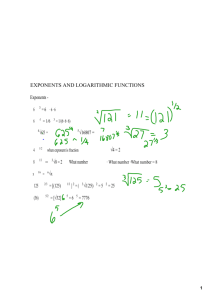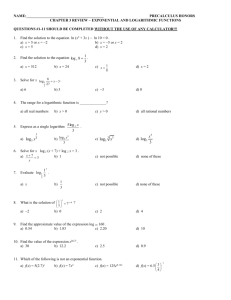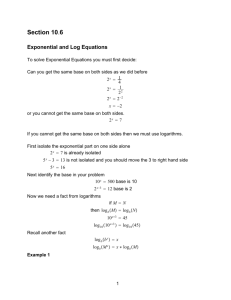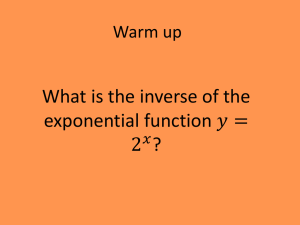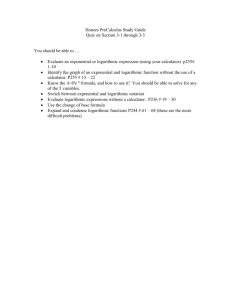Log 7, S94
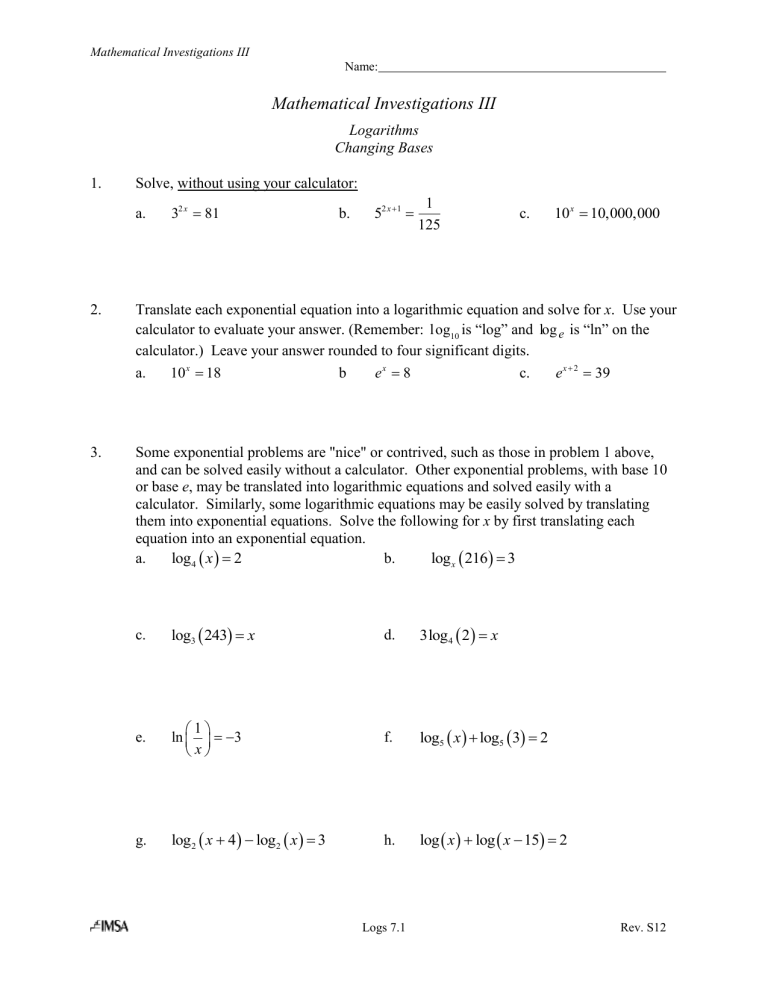
3.
2.
Mathematical Investigations III
Name:
Mathematical Investigations III
Logarithms
Changing Bases
1. Solve, without using your calculator: a. 3
2 x
81 b. 5
2 x
1
1
125 c. 10 x
10,000,000
Translate each exponential equation into a logarithmic equation and solve for x . Use your calculator to evaluate your answer. (Remember: l og
10 is “log” and calculator.) Leave your answer rounded to four significant digits. log e
is “ln” on the a. 10 x
18 b e x
8 c. e x
2
39
Some exponential problems are "nice" or contrived, such as those in problem 1 above, and can be solved easily without a calculator. Other exponential problems, with base 10 or base e , may be translated into logarithmic equations and solved easily with a calculator. Similarly, some logarithmic equations may be easily solved by translating them into exponential equations. Solve the following for x by first translating each equation into an exponential equation. a. log
4
2 b. log x
3 c.
3
x d. 3log
4
x e. ln
1
3 f. log
5
5
2 g. log
2
x
4
log
2
3 h. log
log
x
15
2
Logs 7.1 Rev. S12
Mathematical Investigations III
Name:
Many applications produce problems that are not "nice". We have already dealt with some of these problems using our calculators and either tracing or using the "SOLVE" feature. Problems involving half-life, finding the amount of time for a deposit to reach a specific value, or for a population to reach (or decline to) a specific level are of this nature. Let's consider another way to solve these problems, using logarithms.
Consider the problem:
A family deposits $10,000 into a certificate of deposit that earns 5.35% interest, compounded quarterly. How long will it take the CD to be worth $14,000?
Set up an equation to solve this problem:
Your equation should be in the form:
V
A
1
r
4 t
4
Divide both sides by A .
Now take the log e
of both sides:
Your equation should now be in the form of ln
V
A
ln
1
r
4 t
4
Now use the Laws of Logarithms to solve the equation for t and answer the original question. Remember that the interest is compounded quarterly.
Logs 7.2 Rev. S12
Mathematical Investigations III
Name:
Let's formalize what we did. We already know that an exponential equation of the form u can be written as a logarithmic equation of the form
log u
= x x = v
. But neither form helps to find x unless u is either 10 or e , or v is a known power of u . In other words, we need a systematic way to solve equations similar to
2 x
5 or x
log
1.05
4.11
Let's start with the exponential equation u x v (which is equivalent to log u
x ).
First, take the log b
of each side of the exponential equation:
Now, apply the Third Law of Logarithms to the left side:
Finally, solve for x :
Thus the solution to the exponential equation is found in a logarithmic expression.
4.
Change of Base Formula: x and
If u then
log
x = log log b b u
= v v
,
= x ,
, b > 0, b
1
Use the change of base formula to compute each logarithm. (Introduce a new base to rewrite each expression. Then approximate each, accurate to three decimal places.) x
log 100
3
b. x
log 15
8
c. x
log
1.05
4.11
a.
Logs 7.3 Rev. S12
Mathematical Investigations III
5.
Name:
Solve for x in each equation, leaving your answer as an exact value of a log with the indicated base. a. Example: 5 x
64 , base 2 x
log
5
(64)
log
2
(64) log
2
(5)
6 log
2
(5) b. 3 x
108 , base 3
6.
c. 2 x
3
432, base 2
d. 25 x
1
160 , base 5
Solve each equation for x in terms of logs. Then use the change of base formula and approximate each to 3 decimal places. a. 2 x
7 b. 5 x
100
c.
1
0.276
12 t
12
2 d. 7 5 x
3 11 x
Logs 7.4 Rev. S12


